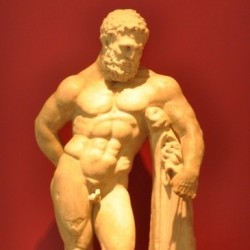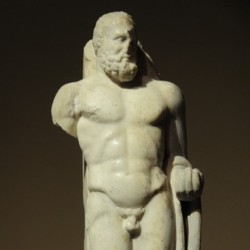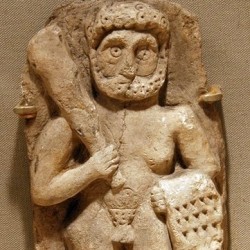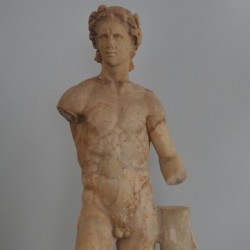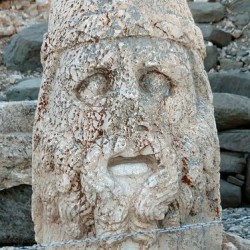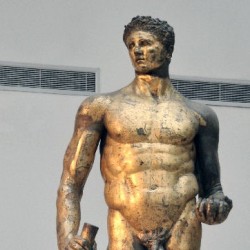Heracles
Heracles (Latin: Hercules): most important of the Greek demigods. Several dynasties, like the twin royal houses of Sparta and the Argeads of Macedonia, claimed to descend from this son of Zeus.
Youth
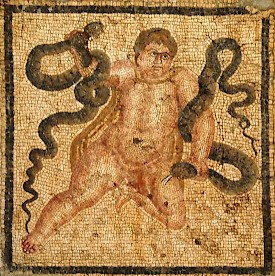
According to the ancient Greeks, the demigod Heracles (or Hercules, as the Romans called him) was the son of a mortal woman named Alcmene and the supreme god Zeus. Zeus' lawful wife Hera hated the child born out of wedlock, and sent two snakes to kill the baby. However, the young boy killed the animals. Heracles became a strong warrior, but Hera struck him with madness, and he killed his own children.
When he had recovered, he consulted the oracle of Delphi, which ordered him to serve his relative Eurystheus, the king of Tiryns, who would order him to perform "the twelve labors".
Lion of Nemea
Heracles' first task was to kill the lion of nearby Nemea, a terrible beast. It was resistant against all weapons, but Heracles strangled it. From now on, he wore the lion's invulnerable pelt as armor. The Greeks celebrated Heracles' victory every two years at the Nemean Games. It is an interesting question where this story comes from. Lions were extinct in Greece as early as the Mycenean age; the story may have come from the east, or may be extremely old.
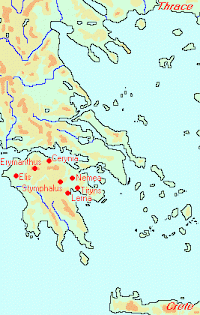
After this labor, Heracles had to perform many other tasks, which were haphazardly described by many ancient poets. There was no distinction between Heracles and other heroes (Theseus, the Argonauts), so that many episodes have duplicates. The first to write a systematic account of Heracles' Twelve Labors was probably Diodorus of Sicily,note, which was written c. 25 BCE. Until then, the number of works had varied; nor was there agreement about the tasks. Several now almost forgotten labors were still well-known in the fifth century.
Hydra of Lerna
Heracles' second labor was to kill the hydra (water snake) of Lerna, another town near Tiryns. This was difficult, because it had nine heads, and every time Heracles cut off one of these, three new heads grew in its place. However, Heracles' friend Iolaus burned down a tree, and the hero used the blazing branches to sear the roots of the new heads. Finally, he cut off the last, immortal head, and buried it alive. After the battle, Heracles dipped his arrowheads in the monster's poisonous gall. As an archer, he was now invincible.
Ceryneian Hind
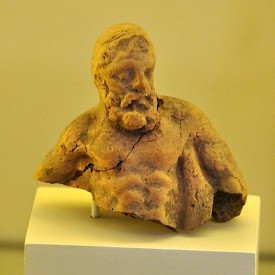
Eurystheus now sent Heracles to Cerynia, where he had to catch a hind that was dedicated to the goddess Artemis. Larger than a bull, this terrible creature destroyed the northern Peloponnese. Heracles pursued it to the northernmost edges of the earth, where the legendary Hyperboreans lived, and finally overcame the animal, which he carried back home.
Erymanthian Boar
The Erymanthian boar lived on the slopes of the Erymanthus, a mountain range in the northern Peloponnese. Again, it was a dangerous monster that ravaged the farmer's fields. After a brief visit to the Centaurs, Heracles drove the animal into the snow, where he was able to capture it. On his shoulders, he carried the animal back home.
 Heracles and the Nemean Lion |
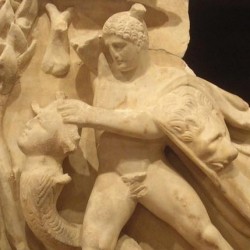 Heracles and the Hydra |
 Heracles and the Ceryneian Hind |
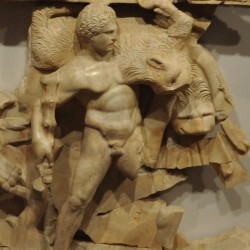 Heracles and the Erymanthian Boar |
Augean Stables
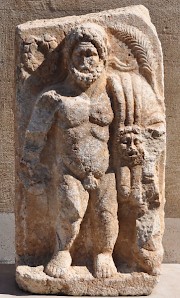
Heracles' next labor was to cleanse the notorious stable of king Augias of Elis, in one day. The demigod ignored the terrible stench and bravely started to carry the dung away, but there was simply too much of it. Accepting the advice of Iolaus, he diverted a river through the stables, which swept away all the dirt.
On his return to Tiryns, however, king Eurystheus refused to accept this as a really performed task. Until then, it had been agreed that Heracles would do ten labors, but Eurystheus now decreed that his relative had to perform two additional tasks: one as a compensation for the help of the river god, and one as a compensation for the assistance of Iolaus when he had killed the hydra of Lerna.
Stymphalian Birds
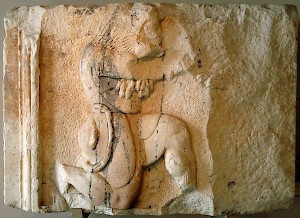
The sixth labor was to remove the countless man-eating birds that invested the marshes near Stymphalus. They had wings, claws and beaks of metal, and were dedicated to the war god Ares. Initially, even Heracles' arrows were inadequate, but the goddess Athena gave him a rattle that had been made by Hephaestus. The birds were terrified and flew away to the Black Sea; the remaining animals were killed by the poison arrows. From now on, there were no monsters on the Peloponnese anymore, and the next labors would bring Heracles to the edges of the known world.
Cretan Bull

Heracles' fight against the Cretan bull was his next labor. The sources disagree about the nature of this animal: was it the father of the Minotaur or the animal that carried Europa from Phoenicia to Crete? To make matters more complex, the same story is told about the Athenian hero Theseus. However this may be, in the canonical sequence of labors, the Cretan bull is number seven, and the first of four voyages that brought Heracles to the south, north, east and west.
Mares of Diomedes
King Diomedes lived in barbarous Thrace. Eurystheus ordered Heracles to capture Diomedes' four flesh-eating mares. Heracles went north, captured two cobolds called Kercopes (initially one of the main labors, but not according to the official canon), and visited his friend Admetus in Thessaly. In return for the hospitality, Heracles descended in the Underworld, where he liberated Admetus' recently died wife Alcestis. Having settled this matter, Heracles reached Thrace, killed Diomedes, and fed him to his own horses.
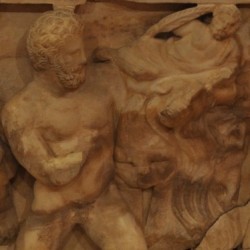 Heracles and the Augean Stables |
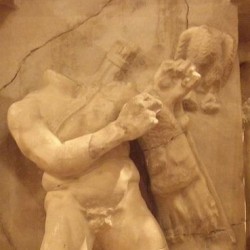 Heracles and the Stymphalian Birds |
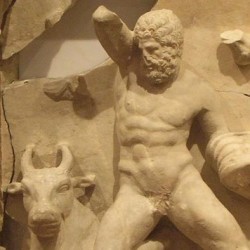 Heracles and the Cretan Bull |
 Heracles and the Mares of Diomedes |
Belt of Hippolyte
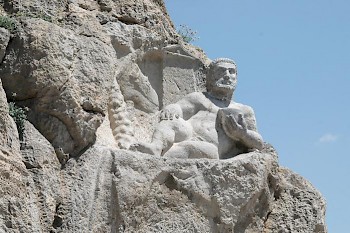
Hippolyte was queen of the Amazons, a legendary tribe of female warriors living on the southern shores of the Black Sea. Eurystheus demanded her belt, which he wanted to give to his daughter Admete. Heracles manned a ship and sailed to the east, in a voyage that resembles the better-known story of the Argonauts, and which included a first Trojan War. When the Greeks arrived in the country of the Amazons, Hippolyte fell in love with Heracles and wanted to give the girdle spontaneously. However, Hera spread the rumor that the Greeks wanted to abduct the queen of the female warriors. War broke out, and Heracles was forced to kill Hippolyte.
Cattle of Geryon
In the far west lived Geryon, the three-headed king of a mythological kingdom that was later identified as Cadiz. Eurystheus ordered Heracles to steal the cattle of Geryon. When Heracles had defeated him, he erected two columns to commemorate his victory: the Pillars of Heracles - what we call the Strait of Gibraltar. On his way back, Heracles founded several towns and dedicated cult sites to himself, a.o. at Rome (the temple of Hercules at the Forum Boarium) and Sicily. The historical truth behind these stories is the Phoenician colonization: everywhere, the Phoenicians dedicated temples to Melqart, a god that was later identified with Heracles.
Hesperides' Apples
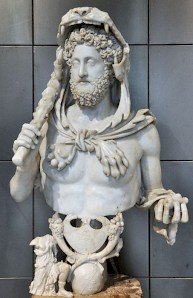
Now, Heracles had to obtain the apples of the Hesperides, or "western girls". They were the daughters of Atlas, the giant that carried the heaven on his shoulders. The Hesperides guarded an orchard with golden apples. It is possible that behind this story is a historical tribe of female warriors that lived in modern Mali, and controlled the trade in gold. On his way back, Heracles visited the oracle of Zeus Ammon at Siwa, and founded the Egyptian city of Thebes.
Cerberus
Heracles' final labor was to catch Cerberus, the three-headed dog of the Underworld. This brought him back to the Peloponnese, where an entrance to the Hades could be found at Cape Tanaerum. During his last fight, Heracles was protected by the pelt he had obtained during his first labor. When he returned with the dog of hell to Eurystheus, Heracles was free. He immediately avenged himself by killing three of Eurystheus' sons. Heracles now became king of the Peloponnese and married Deianeira.
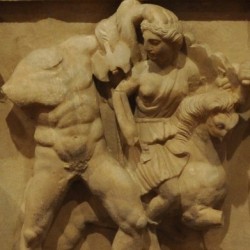 Heracles and the Belt of Hippolyte |
 Heracles and the Cattle of Geryon |
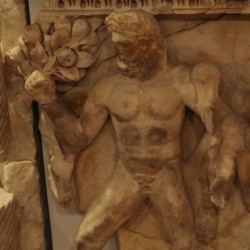 Heracles and the Apples of the Hesperides |
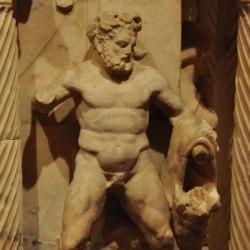 Heracles and Cerberus |
Death
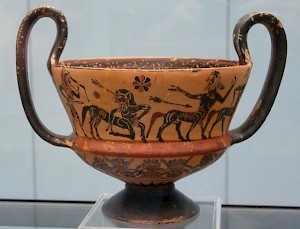
Heracles did many other things. When he and Deianeira once crossed a river on the back of a centaur named Nisos, it tried to rape the woman, but was killed by Heracles' poison arrows. The centaur tricked her to use his blood to paint her shirt and give it to Heracles. When he wore it, he was struck by hellish pains, erected a pyre, and burned himself. After his death, he became a god or, in other traditions, a constellation.
Later generations venerated him. The kings of Sparta and Macedonia claimed to be descendants of the demigod, and in the Hellenistic age, many Greek colonies in the Eastern Mediterranean claimed Heracles as their founder. He was commonly associated with Melqart, a Phoenician deity who was venerated in nearly every Phoenician colony.
Roman emperors (e.g., Domitian, Commodus, Septimius Severus, Postumus, and Maximianus) used Hercules in their propaganda.
